iPad mini Review
by Anand Lal Shimpi & Vivek Gowri on November 20, 2012 6:10 PM ESTDisplay Analysis
As with a discussion on performance in mobile devices these days, the iPad mini's display requires both an experiential analysis and an objective performance analysis. I'll begin with the experience.
Without a doubt, the iPad mini presents an evolution in form factor and nothing else. Everything from silicon to display technology are known quantities at this point. While it's true that in many senses, even Apple's previous generation mobile hardware is pretty good, the fact of the matter remains that the mini doesn't push the envelope in anything but form factor. That's not necessarily a bad thing, it's just reality. I should also point out that many smaller-versions-of-bigger-things follow this same approach of not pushing the performance envelope for obvious reasons.
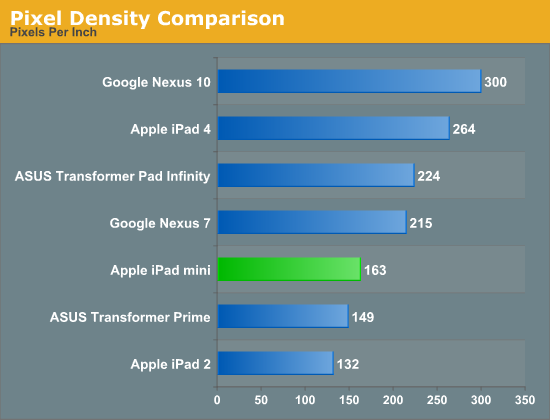
Doing the math on the mini's 1024 x 768 display results in a pixel density of 163 pixels per inch. A tangible improvement compared to the original iPad's 132 PPI, but keep in mind the smaller screen may have to be held closer to your eyes. Compared to other tablets, the mini's display resolution isn't anything to write home about. In practice, the mini's makes reading small text a problem:

While the 3rd and 4th gen iPads have a large enough display at a high enough resolution to make it possible to view the Dell configurator in the photo above without zooming, the same can't be said for the iPad mini. You're going to need a double tap.
Although reading text is one area where the absence of insane numbers of pixels is clearly obvious, it's visible in some photos as well.

iPad mini (left) vs. iPad 4 (right)
Where a lack of fine detail doesn't get you, the physical size of the display may. I was pleasantly surprised by the usefulness of Apple's 7.85-inch display, but given my early affinity towards 8-inch tablets it's not too shocking. Despite how useful the mini's display is, I found myself having to double tap to zoom in on most desktop websites just to make the reading a bit better. It's not that the process of zooming in on a website in mobile Safari is particularly cumbersome, it's that the fact that I have to makes me feel like I'm using more of an iPod Touch and less of an iPad. I do admit the feeling is quite irrational as I prefer keeping the iPod Touch (or iPhone in the case of, reality) holstered and using the mini instead. This is less a criticism of the iPad mini and more guidance for those deciding between mini and regular sizes of the iPad.
Compared to a true 7-inch tablet like the Nexus 7, the additional screen size is definitely appreciated - particularly when reading web pages:
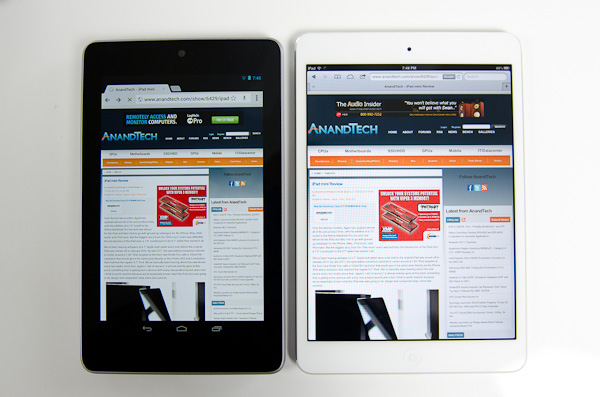
Nexus 7 (left) vs iPad mini (right)
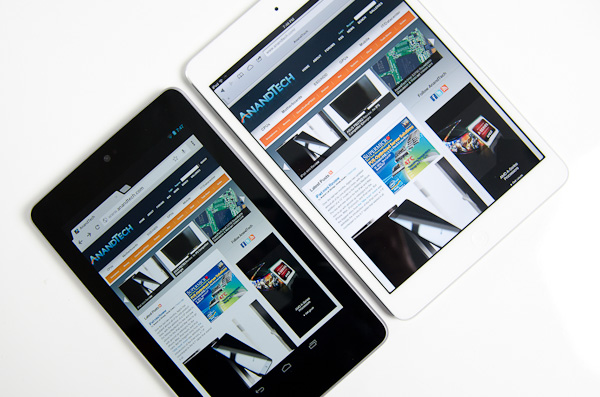
Nexus 7 (left) vs iPad mini (right)
When Vivek and I brought up the topic of the mini's lower pixel density on the Podcast, our own Brian Klug pointed out the obvious: we're spoiled. How impressed/unimpressed you are with the iPad mini's display really depends on what other displays you've been exposed to. In a vacuum, the iPad mini's display is fine. Brightness, black levels and contrast are all reasonable (and much better than most notebooks). Color reproduction isn't bad either. In the spectrum of all displays available at the mini's price point, this 7.85-inch 1024 x 768 panel isn't bad. Spend any appreciable time with the bigger iPad's Retina Display however, and your opinion will quickly change.


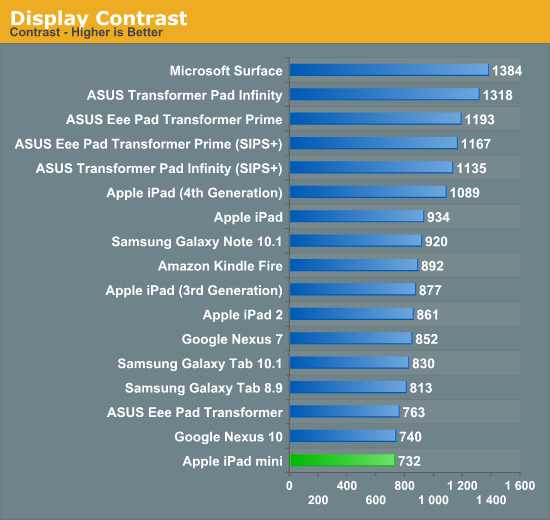
In our Surface review I titled the display section "Not Retina, But Still Good". Compared to the Surface display, the mini has better color accuracy but clearly loses out in black levels thanks to Microsoft's laminated display + cover glass stack.
To evaluate color accuracy I turned to our own Chris Heinonen's CalMAN smartphone/tablet workflow. We'll start off by looking at the calibrated white point for these tablets. What you're looking for here is a number close to 6500K:
The mini doesn't really diverge from other iPads here, although Microsoft comes closer to 6500K at 200 nits.
The next three charts look at accuracy represented as a difference between various source colors and what's reproduced on the display. The results are presented as average dE2000, with lower numbers being better.
First up is Grayscale performance, here we're looking at the accuracy of black, white and 19 shades of gray spread in between the two extremes:
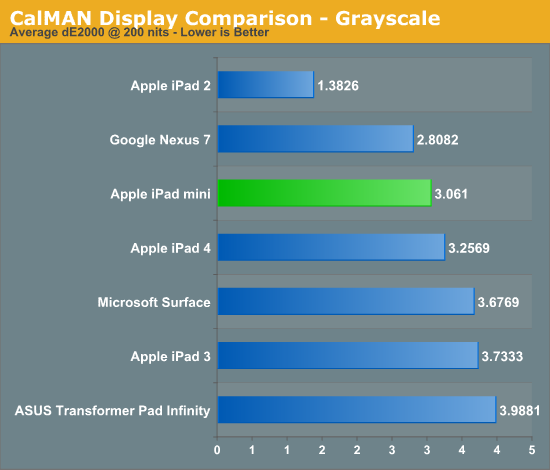
The mini does reasonably well here, it actually ends up a bit better than the 4th gen iPad. Grayscale accuracy doesn't seem to be too difficult for most folks to get right, but what happens when we start looking at colors?
First in our color accuracy tests is a saturation sweep. Here we're looking at 20%, 40%, 60%, 80% and 100% saturations of red, blue, green, magenta, yellow and cyan.
Now we start to see the retina equipped iPads pull away from the mini. Compared to the iPad 2 and even Microsoft's Surface, the mini looks pretty good, but if you compare it to the Nexus 7 or newer iPads it's clearly at a disadvantage. All of these displays are significantly better than the average notebook panel. As I mentioned earlier, it all boils down to perspective and expectations.
Gamut CIE Chart

Saturation CIE Chart

For our final accuracy test we're looking at the difference between a Gretag Macbeth colorchecker chart and the rendered swatches on these displays. Once again, lower numbers are better.
Once again, the iPad 3/4 can't be touched here, with the iPad mini falling significantly behind. Colors simply look better on the bigger iPads. The Nexus 7 does better here as well. Subjectively I found colors on the Nexus 7 to look appreciably more accurate than on the mini.
GMB Color Checker
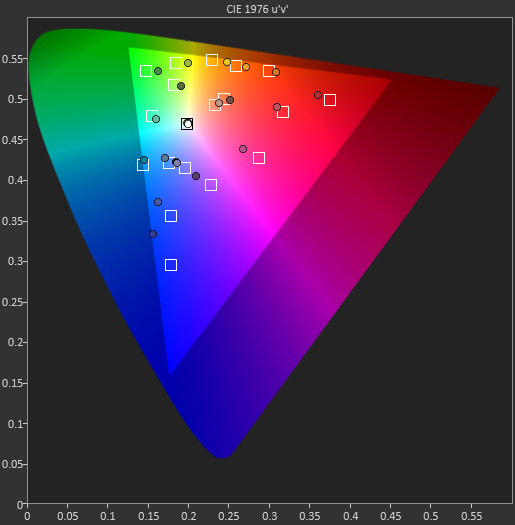
With regards to the quality and accuracy of the images rendered on the mini's screen, I feel the same way about it as I do the display on Surface: it's not a Retina display, but still good.


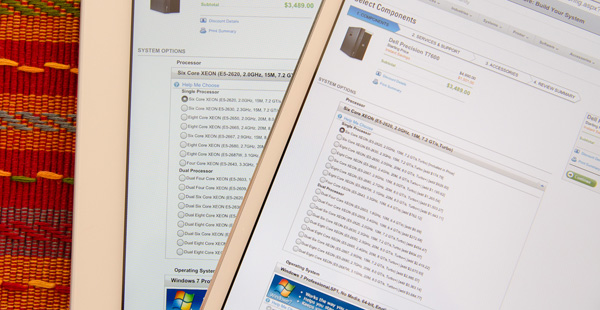
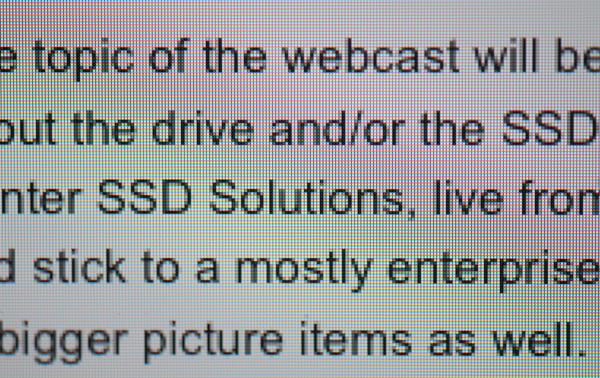
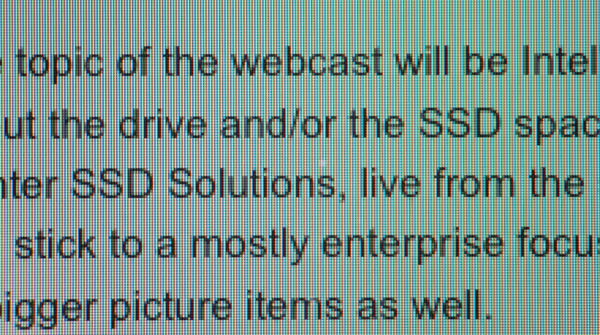
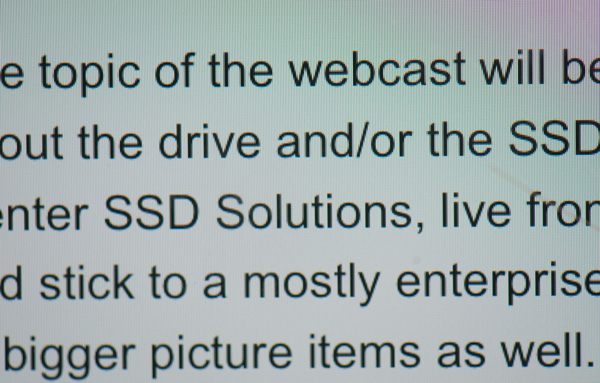
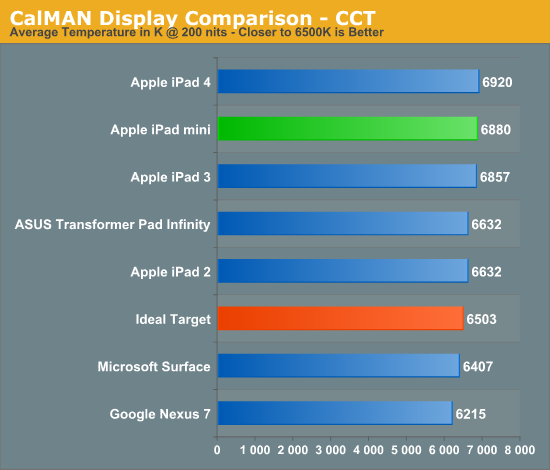
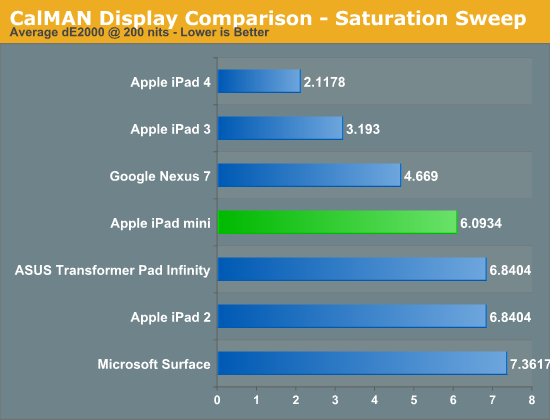
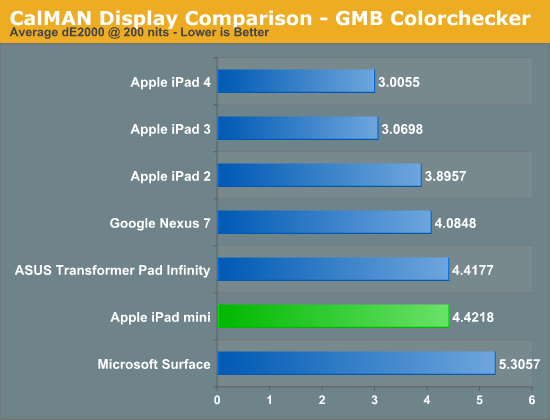








140 Comments
View All Comments
Calista - Wednesday, November 21, 2012 - link
^+1I bought the original iPad and as many was amazed by the build-quality (stupid sharp edges excluded) and how fluid surfing the web felt considering the hardware. But I also within 15 minutes realised that it was badly memory-starved. Apple is an amazing company taking great pride in the user-experience of its products, but back then they goofed up badly.
I feel the same about the Mini. The CPU may be old but it's still fairly competent, the GPU still among the best, and the screen size may be close to perfect. But only 512 MB of RAM just ain't sufficient for today, even less for tomorrow.
ltcommanderdata - Wednesday, November 21, 2012 - link
Being slow to increase RAM and VRAM is consistently an issue with Apple. That's the case with Macs as well.For the iPad 1, it wasn't just that 256MB of RAM was small. Rapid drop-off in app support for the iPad 1, especially in games, is due to the resolution being so high in comparison to the RAM. The GPU was also underpowered compared to the resolution. 3rd gen devices have 480x320 screens and 256MB of RAM while the iPad 1 has 5.1x the pixels with the same 256MB of RAM. The 4th gen iPod Touch is affected by this too having a 960x640 screen with 256MB, but the iPad 1 is even worse with 1.3x the pixels of the 4th gen Touch. Support for the 4th gen iPod Touch in games isn't perfect, but is better than the iPad 1, which indicates that 256MB in itself isn't the limitation, but the drop in support for the iPad 1 is a combination of 256MB RAM with the higher 1024x768 resolution and the iPad 1 no longer being sold after 2011. The iPad 1 received 2 major OS updates (iOS 4.x and 5.x) post launch like other iOS devices so its OS support wasn't prematurely terminated.
I think the situation will be different for the iPad Mini 1. The iPad 2/Mini doubles the RAM to 512MB while keeping the resolution the same, which alleviates the poor resolution-RAM ratio of the iPad 1. 512MB of RAM represents the majority of iOS devices including the iPhone 4, iPhone 4S, iPad 2, iPad Mini 1, and 5th gen iPod Touch, of which given historical patterns, the iPhone 4S and 5th gen iPod Touch and perhaps even the iPad Mini 1 itself will sell into 2014. Given historical patterns, OS support for the iPhone 4S, 5th gen iPod Touch, and iPad Mini 1 should continue into 2015. Seeing it's only in 2012 that developers are really beginning to require 512MB of RAM, I don't see them already upping the minimum requirement to 1GB in 2013. Especially not when that eliminates the majority of their potential customer base, when those devices are still being actively sold into 2014, and receiving OS support into 2015. I think 2014 is a more realistic date for when apps will begin to stop supporting 512MB devices.
Personally, seeing the CPU was unchanged and the GPU is only 2x faster despite the 4x increase in resolution making it slower at native resolution than the iPad Mini 1 and iPad 2, I wouldn't be surprised if the iPad 3 loses app support before the iPad Mini and iPad 2.
Of course, just because apps continue to support 512MB devices doesn't mean the usage experience won't be degraded or sub-par. I can see that becoming an issue faster than app support.
Klug4Pres - Wednesday, November 21, 2012 - link
I guess you reviews the Wifi-only version, but I'd like to see some analysis of the cellular connectivity options, especially what LTE bands are supported in the available SKUs.HighTech4US - Wednesday, November 21, 2012 - link
The mini lacks a GPS on the base model making it useless for using any map software with turn-by-turn prompts.The Nexus 7 has a built in GPS chip (and a very effective one and way better pin pointing location than a TomTom) and Google Maps works great on the Nexus 7 (you can download maps for offline use).
The lack of GPS on any tablet is a deal breaker for me.
Adding in the omission GPS with the other short comings along with its sky high price makes the mini just an overpriced iToy. The Nexus 7 is a much much better deal.
Calista - Wednesday, November 21, 2012 - link
I think we have all forgot what gave us forgot what gave us 7" tablets. A "tablet" - i.e a tablet PC running Windows was normally in the 12-14" range. The JooJoo was a 12" tablet as well. Apple brought it down to 10" and sold a ton of those.At the same time a large number of more or less obscure manufacturers brought out 7" tablets *not* because 7" was considered the best compromise but because those panels could be bought dirt-cheap. But this also gave us this idea that a small tablet was supposed to be 7" while a large tablet was to be 10". I would say this is an anomaly, tablets have for the last ten years been larger than 10".
Maybe the "correct" size for a small tablet is in the 8-8.5" range? I was playing with my friends Motorola Xoom 2 (8.2", 1280x800) and while a bit heavier than my 7" tablet it seemed to hit the perfect size. Not so big or heavy as to be cumbersome, while still packing almost 40" more screen area.
Too much focus is being put on the device being pocket-able, how many really bring a tablet in their coat or pants? Just the idea of asking for a device to be pocket-able while still lacking a 3G/4G connection is just plain silly. Instead focus should be put on how it feels in hand but also how much space it occupies on a table. The 10" iPad was always too big to fit comfortable on my table while still having space for a cup of tea, a notebook, a plain book or the remotes for the TV and receiver.
Quad5Ny - Wednesday, November 21, 2012 - link
There is a Pop-over interactive banner ad running that opens when you try to hit the x, please take a look. Thanks.http://forums.anandtech.com/showthread.php?p=34271...
vicbdn - Wednesday, November 21, 2012 - link
"but in terms of repsonsiveness" In the conclusion.BSMonitor - Wednesday, November 21, 2012 - link
Incredibly too much... By the 4th generation of these, 32GB should be standard and 64GB a $100 upgrade...The BOM on 32GB NAND in this fashion is what? $15? Even if it's $20($10 x 2 16GB), they are getting a 1000% profit margin on that upgrade from 16 to 32 GB??
But they know we all have huge iTunes libraries we'd want on it...
Unfortunately there will never be a do-it-yourself tablet similar to the PC market. I stopped paying Dell and Gateway and HP a LONG time ago for their ridiculous profit methods.
TouchPadKing - Wednesday, November 21, 2012 - link
Not sure if this has already been rehashed, but the pixel size is what kills the ipad mini for me. I have a Samsung Galaxy Tab 7.0 Plus, and I can SEE the pixels and it drives me nuts. The ipad mini has an even bigger screen with about the same number of pixels... Also, samsung fits in pocket, mini doesn't. I like the ipad mini's form factor, but again if it won't fit in my pocket it'll probably never leave the house...Rising - Wednesday, November 21, 2012 - link
I bought Nexus 7 when it was released. This is what i can tell you after few months of usage.."Its a good hardware in a crappy software". Iwould say the higher price premium on ipad mini is justified for software.
Most of the apps are zoomed over apps for Nexus 7. I hate that part of it. For example i use this app called apex launcher in my samsung s 3 and when i try using it on Nexus 7 all the icons are so small that they are hardly recognizable.
I donot understand why Google cannot optimize the apps to their own Nexus tablets.
Anand do you know whats stopping them from doing this?